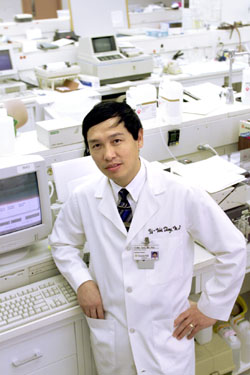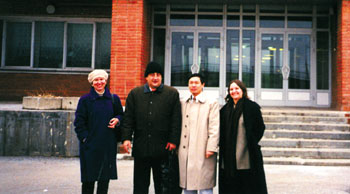
Dr. Yi-Wei Tang is the first Vanderbilt researcher to work on the project. (photo by Dana Johnson)
VUMC helping former Soviets

Dr. Yi-Wei Tang, third from left, stands with Dr. Olga Dorohina and Dr. Vladimir Petrov of VECTOR, and Jessica Kaplan, program specialist for ISTC, outside VECTOR in Siberia.
In an effort to help transition former Soviet Union bioweapons researchers to a more positive enterprise, the U.S. Department of Defense and the Department of Health and Human Services recently funded a program overseen by the newly formed International Science and Technology Center (ISTC), located in Moscow. The ISTC pairs U.S. researchers with Russian counterparts for beneficial collaboration.
Dr. Yi-Wei Tang, assistant professor of Medicine and Pathology and director of the Molecular Infectious Diseases Lab, is the first Vanderbilt researcher, and one of the first in the country from a private research institution, to become involved with the project. He recently returned from a trip to the State Research Institute for Virology and Biotechnology Research in Novosibrisk, Siberia having spent a week at the facility, also famously known as VECTOR, with his collaborator Dr. Vladimir S. Petrov, a Russian virologist.
“The purpose of the program is to do real science through collaboration and to monitor the research of our counterparts,” Tang said. “We want to retain the scientists still there at VECTOR and recruit back the ones that left. If we don’t ask them to do science someone else will. He said the researchers at VECTOR are “great scientists” who want to do positive work, but they need to make enough money to survive.
At the time of the breakup of the former Soviet Union, the communist government employed over 4,000 people, many who were M.D., D.Sc., or Ph.D. level scientists engaged in research to create and produce biologic weapons for the purpose of mass genocide. The research was mainly carried out at VECTOR. The huge complex is located in a remote region of Siberia located five hours by air from Moscow.
Now, VECTOR is a large, decaying, financially troubled complex of about 40 buildings. Along with the Centers for Disease Control, VECTOR has the distinction of being the only other facility in the world officially recognized to contain living strains of smallpox. Today, researchers at the facility are trying to convert to peaceful work for the betterment of mankind.
Currently, about 2,000 employees remain at VECTOR, with about 150 doctor-level scientists. Only a few of the buildings remain open for research. Many in U.S. research and intelligence communities wonder what happened to some of the world’s most experienced bioweapons experts. The real concern is that in order to feed themselves and their families some of these researchers may now be employed by rogue nations to develop or perfect biologic weapons programs.
The once thriving research complex received approximately 80 percent of its funding from the Soviet government before the fall of Communism. As the Soviet government toppled, funding to the facility was slashed. Now, VECTOR receives about 8 percent of its former funding, resulting in the loss of employment for all but a few of the researchers.
The collaborative program to employ Russian researchers now has financial assistance from certain pharmaceutical companies in addition to U.S. government funding. The funds are pooled and distributed by the ISTC.
Since the events of Sept. 11, the program has taken on renewed significance. Tang quickly summed up the situation. “By doing good for them we are doing good for ourselves,” he said.
Tang returned from his week in Siberia with vivid memories. “VECTOR is a huge institution, a lot like our National Institutes of Health,” he said. “Many of the people remaining at this enormous complex are there just to guard the facility.”
Tang said that despite the exodus of scientists, security remains high at VECTOR. “To get inside the facility you must go through two outer barriers,” he said. “The viruses are very safely guarded.”
While there, Tang got to visit the building that houses their smallpox strains. He said that in early November the temperature in Novosibrisk was already 10 degrees below zero.
Guidelines for a researcher to become involved with the ISTC collaborative project are broad. The research needs to be beneficial in some way to Russia or America. The researcher has to meet with his collaborator once a year and periodically review reports. Tang said that almost any researcher at VUMC would meet the qualifications particularly those in microbiology or infectious diseases.
Tang and Petrov are laying the groundwork for pathogenesis research on Crimean-Congo Hemorrhagic Fever (CCHF). From the same family of hemorrhagic fevers as the dreaded Ebola Virus, CCHF is present in southern parts of the former Soviet Union.
“The virus was originally isolated from two different areas, the Congo in Africa, and the Crimean Mountains in the former Soviet Union,” he said. “CCHF is a very bad virus with a high death rate.” The disease is presently found in Russian, Africa, and parts of China.
Tang and Petrov are sequencing isolates of the tick-borne virus, which can in the worst cases cause symptoms similar to, but not as severe as Ebola. He says CCHF has a varying mortality rate of 5 percent to 25 percent, depending on the strain and who gets the disease.
“What’s interesting about CCHF is there are apparently varying symptoms for different races,” he said. “Because Russia is such a racially diverse country people of different races get the disease. We can look at how the different host’s polymorphism may affect how the disease affects them.
“Some patients get only mild flu-like symptoms with CCHF while others develop hemorrhagic fever leading to severe shock and then death.”
Tang encourages other VUMC researchers to get involved in collaborative efforts with VECTOR scientists. “The more people that get involved, the more money the U.S. Department of Defense and Health and Human Services is willing to contribute,” he said.
“I am pleased that our faculty are sensitive to being citizens of the world and are willing to contribute their background knowledge and considerable creativity to these life-saving efforts,” said Lee E. Limbird, Ph.D., associate vice chancellor for Research.
“There are many opportunities to do some great collaborative research,” Tang said. “Do it for the science and eventually for our survival.”
If you are interested in information about the International Science and Technology Center’s collaborative research program contact Tang at 3-1289.













